 |
|
||||||||||
|
 |
|
||||||||||
|
The Compleat Lexical Tutor, v.4
| Title |  |
| Author | Tom Cobb |
| Web address | http://www.lextutor.ca/ |
| Product Type | Website with concordancer, vocabulary profiler, exercise maker, interactive exercises, and much more. |
| Platform | Windows, Macintosh |
| Minimum System Requirements: |
|
| Contact | http://www.lextutor.ca/mailer/ |
| Price | Free |
Learners learn vocabulary by recycling. Keith Folse (2004) writes of the importance of providing learners with multiple exposures to new words, so that the words will move from short-term to long-term memory. This view is also supported by Tom Cobb (1999), whose research demonstrates that when learners encounter words in a variety of contexts they are able to retain and use them flexibly. The Compleat Lexical Tutor offers a means of doing just that. With its focus on academic vocabulary, the site will perhaps be of greatest interest to those working with English for Academic Purposes (EAP) learners.
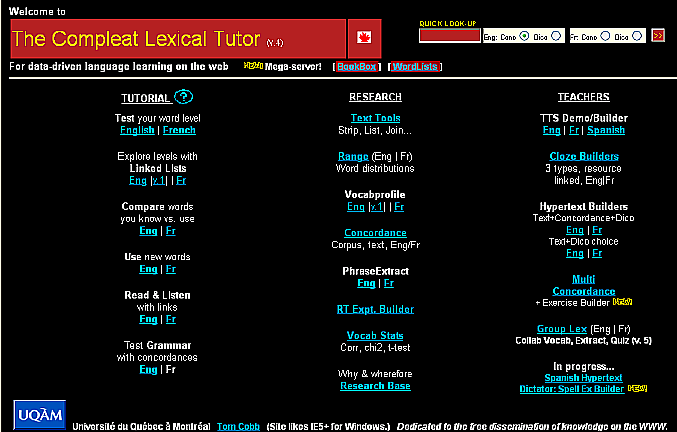
Figure 1: The Compleat Lexical Tutor, site entry web page
Dedicated by its webmaster, the aforementioned Tom Cobb of the University of Quebec at Montreal (UQAM), "to the free dissemination of knowledge on the WWW," this website contains a vast range of resources for both teaching and learning vocabulary and grammar. As can be seen from the entry page, the site focuses not only on English but also French and Spanish; however, this review will focus on English resources. Since this is quite a large site, with some sections more "finished" than others, it requires some trial and error exploration on the part of the instructor before employment in the classroom. However, the majority of the programs have been "validated empirically in peer-reviewed papers that are fully and freely available" (T. Cobb, personal communication, November 7, 2004). [-1-]
The Compleat Lexical Tutor is divided into three sections: Tutorial, Research, and Teachers. A good place for a newcomer to begin would be in the Research section, under Why & Wherefore/Research Base. Here Cobb explains the rationale for learners to use vocabulary lists: " . . . if you know the first 2000 [most frequently used English words] plus [the] 570 AWL words, then you know about 90% of the words you will meet in any academic text" (n.d., ¶ 16 ). Most of the nearly three dozen or so tools and activity builders are based on either the Academic Word list (AWL) [1] or concordancers.
Many instructors of EAP will be familiar with the AWL, a set of 570 high-frequency words that appear in academic texts. These are arranged in a set of 10 sublists, with words on Sublist 1 being the most frequently used, and those on Sublist 10 being the least frequent. More basic are K1 and K2 lists, from the General Service List (West, 1953, cited in Bauman & Culligan, 1995), which contains the 2000 most frequently used words in English; K1 has the most frequently used words and K2 the less frequent (on the Word Lists link on the index page of this site, K1 and K2 are referred to as "1000" and "2000" respectively). These lists appear in various sections of The Compleat Lexical Tutor, notably in the Web Vocabulary Profiler, (Figures 4 and 5).
The Tutorial section aims to provide self-access learning opportunities for learners. Using interactive tools on the web site, learners can test their vocabulary, explore their vocabulary levels, compare active and passive vocabulary, use new words, read and listen to a novel, and test their grammar with concordances. Four of the Tutorial activities are described below.
Test Your Word Level is adapted for the web from Paul Nation and Batia Laufer's word levels tests, developed for learners with vocabularies of different sizes and types, with the 1000 to 10,000 most frequent English words, including the University Word List, an earlier list of academic words developed by Nation and Xue. At the 1000 word level, the items are multiple-choice and based on either pictures or short sentences. Beyond this, the items are all gapped-words in sentences, as seen in Figure 2.

Figure 2: Test Your Word Level, gapped-word item
Learners check their answers and move on to a second test at a higher or lower level, depending on their score.
My pre-entry EAP learners found these tests easy to use but rather alarming, as they discovered their vocabulary was not as strong as previously thought. Their performance on the tests prompted them to investigate the Learn Words link, which takes one to the Linked Lists and guides learners to the words they have answered incorrectly. Learners type in the word and can hear it pronounced, using the "Speaks for Itself" text-to-speech (TTS) plug-in (available from the site and at www.speaksforitself.com), or can look at a concordance of the word (based on the Brown Corpus) to see its use in context. Then they can locate the definition through a link to WordNet [2], an online dictionary from Princeton University.
Learners are also invited to use their own writing with the Web Vocabulary Profiler (see description under "Research"), which compares their passive vocabulary (based on their Test Your Word Level results) to their active.
Concord Writer focuses on helping learners activate their passive vocabulary. They write or paste their own text into a "scratchpad" window and then choose a concordancer (ranging from Brown to Anne of Green Gables--it is a Canadian site), to check their use of new words or structures. The rationale for the use of concordancers for vocabulary acquisition is based on two features: first, learners encounter words in authentic and varied contexts; next, they are able to become researchers of language, generalizing rules and principles from multiple "sightings" of words (Nation, 2001). Research on the use of concordancers concludes that this "seems to help learning, especially where use in context is required" (Cobb, 1997, cited in Nation).
Concordance tests provide samples of sentences focusing on prepositions, singular-plural, gerund-infinitive, and simple past/present perfect. Learners read simple sentences, click "OK" or "Not", and check to see if they are correct by using the concordancer. They can also check their own collocations by typing in a keyword such as "approach" and then an associated word, e.g., "to", to see if the two words appear together in texts. Again, there is a link to Word Net so learners can check word meanings. [-2-]
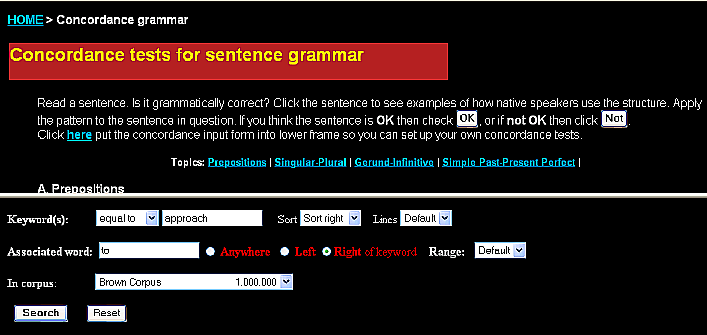
Figure 3: Concordance test
The Research section is divided into eight sub-sections. The first is Texttools, with tools for processing text such as frequency list-makers, HTML-tag strippers (useful for rendering HTML files into text files for further analysis), corpus builders (for those who wish to create their own corpora), and a sentence extractor, which removes end punctuation from sentences in texts. Next are: Range, which enables the researcher to locate words and phrases in different corpora; VocabProfile--the Web Vocabulary Profiler; Concordance tools with links to English and French concordancing programs; Phrase Extractor, which enables one to analyze text for repeated phrases of 2-5 words; and the RT Expt. Builder (Reaction Time Instrument Builder), a tool used to test the speed of learners' word recognition (at present it is not available for Mac users). Vocab Stats is a collection of programs for researchers who wish to generate different types of statistical information about patterns of vocabulary in texts; it links to Richard Lowry's Concepts and Applications of Inferential Statistics at Vassar. Finally, the aforementioned Why & Wherefore/Research Base contains links to a number of Cobb's research papers as well as to other pieces of research and websites dealing with the topic of "list and frequency-based vocabulary learning." Among these, the Web Vocabulary Profiler and Concordance tools can be used with little difficulty for a range of purposes.
Instructors or learners input text into the Web VP, as seen in Figure 4:
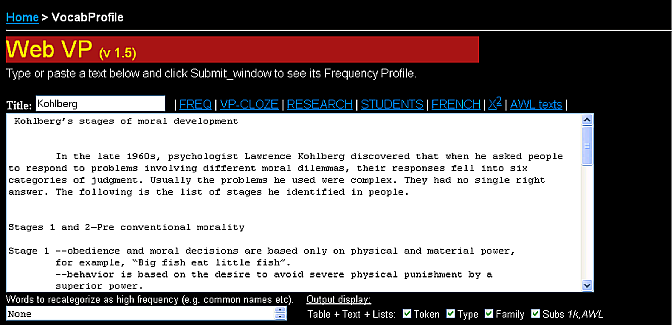
Figure 4: Web Vocabulary Profiler, input
Next, they analyze the output (Figure 5). [-3-]
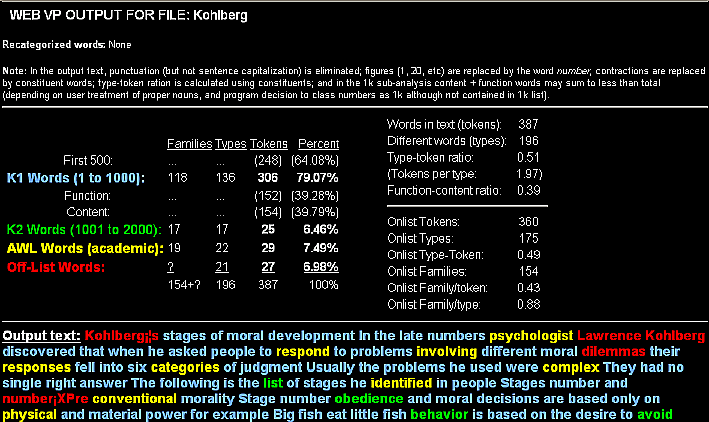
Figure 5: Web Vocabulary Profiler, output
The output for this file shows that the percentage of K1-K2 words is about 76%, while the percentage of words from the AWL is 7.49%. Off-list words, which may include proper nouns, unusual words, specialist vocabulary, acronyms, abbreviations, and misspellings, comprise slightly fewer, contributing 6.98% to the total.
This information will interest instructors who are selecting reading material for class work and want to get a frequency breakdown of the words in the text. It is also useful for selecting vocabulary to study. I recently scanned and input my learners' textbook reading assignments in the Web VP to select a 120-word vocabulary. I frequently ask my learners to bring in news articles to share with their classmates; part of this assignment is to teach their classmates new vocabulary from the articles. They often use (without prompting from me) the Web VP to select the vocabulary.
Of particular interest to instructors is the "type-token ratio," which indicates the number of different words in the text (types) divided by the number of words on which they are based (tokens). If learners are being encouraged to increase the variety of words used in their writing, they will be encouraged by a higher type-token ratio number. Learners can also analyze their own writing with the Web VP; this can be quite instructive. If, for example, learners load a sample of their academic writing from the beginning of a course and compare it to a sample completed at the end they will hopefully see an increase in the percentage and types of AWL words.
Web Concordancer, created by Chris Greaves, links to entries in WordNet. The website has both corpus and text-based concordances in English and French. The 13 English corpora include the Brown and British National Corpus (BNC) in both spoken and written forms. Learners enter words, select the corpus ("All of the corpora" is one option), press a button and see the concordanced output showing chosen words as they have been used in real contexts. Options include adding a second, associated word and generating a collocates table, either alphabetically or by frequency. [-4-]
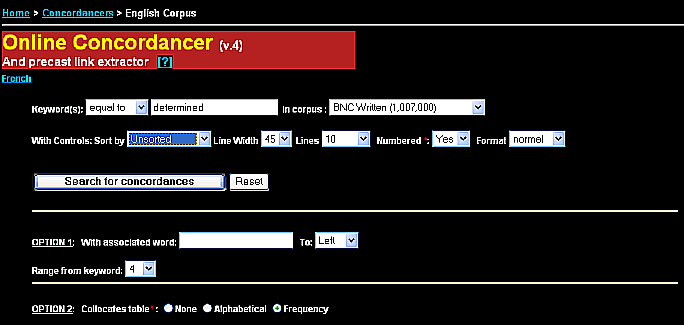
Figure 6: Online Concordancer, interface
Output for "determined" based on the BNC corpus and with a right collocates table is shown in Figure 7 (note that the number of lines and the type of collocates can be selected):
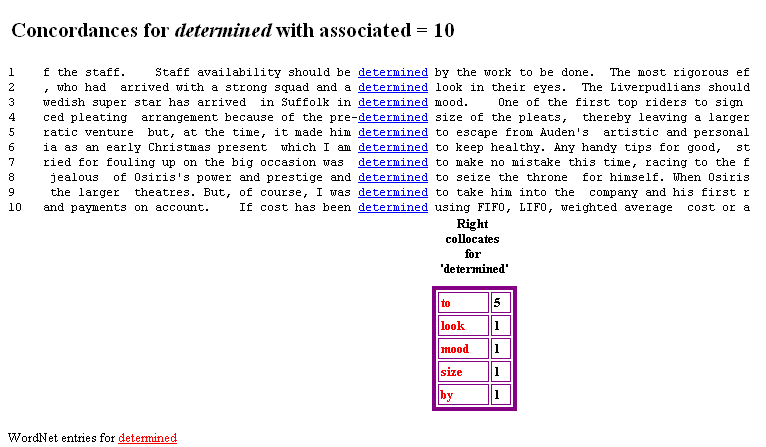
Figure 7: Online Concordancer, output
Like the Web VP, this is quite a powerful tool. At the very least, it offers instructors a means of searching for frequent collocates. Learners, too, can check concordances for frequently used words to see whether their use of these words is appropriate and they can also focus on learning new words according to their most frequent collocations. Learning words in this way offers a means for quickly improving fluency (Nation, 2001). I use the concordancer to raise awareness among learners who misuse reporting verbs. After reviewing the output, my learners return to their written work and correct errors based on their observations of how the words are used in authentic contexts. [-5-]
Text-based concordances offer learners and instructors another means of analyzing writing. Learners can input their own text and produce a concordance index. By clicking on items in the "types" list, users can look at how words were used in the texts and identify frequent uses (or misuses) of language. (Note: this program requires some patience! I encountered frequent error messages and difficulty uploading text files from the hard drive.)
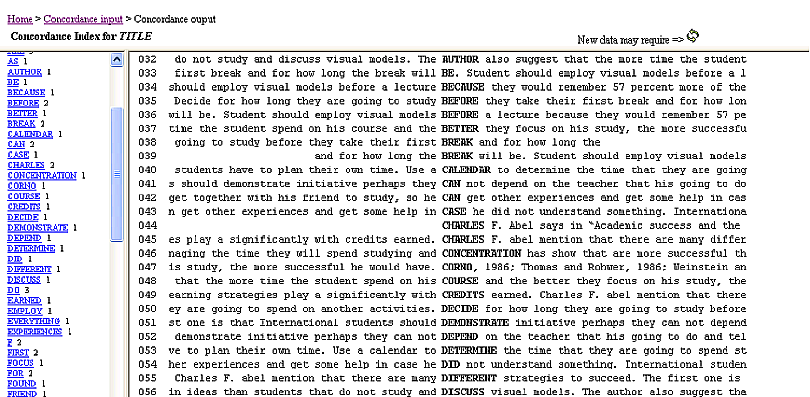
Figure 8: Text-based concordance of student writing
The third section, Teachers, allows instructors to input material to create customized vocabulary practice materials for their students. Among the offerings here are a Text-to-Speech (TTS) builder, three types of cloze builders, a Hypertext Builder, Multi-Concordance with Exercise Builder, Group Lex (a collaborative vocabulary exercise builder), and Dictator, a new addition to this section.
TTS Builder
Available in English, French and Spanish, TTS builder requires the download of the text-to-speech software, Speaks For Itself. The user inputs text, saves it and is then provided a temporary link to the text, which can either be uploaded to a web page or presented in a language lab. Students can use it for multi-modal learning--they can both read and listen to the text. Speaks for Itself can be adjusted for rate and voice variations and can produce individual words or phrases.
Cloze Builders
Both instructors who like their cloze passages basic and those who prefer them with "bells and whistles" will appreciate the technical choices associated with these programs. All are linked to additional resources, including online dictionaries, audio files and, in some cases, video files. [-6-]
Nth-Word and Rational Deletion clozes
Text is pasted into the text window to produce a multiple-choice cloze with drop-down menus (Figure 9). The target words (in the yellow box) can be linked to the Cambridge Advanced Learner's Dictionary, the Online Concordancer (using the Brown corpus), or WordNet dictionary.
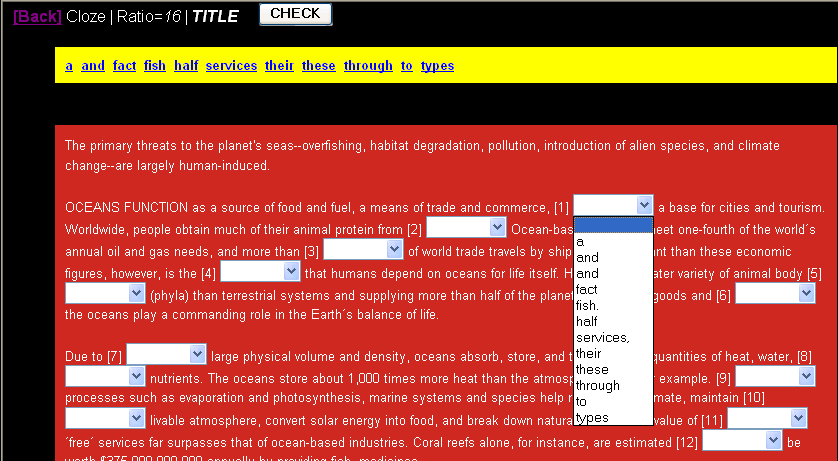
Figure 9: 1/16 word cloze with target words in dropdown answer list.
Still in the experimental stage is Video Cloze, in which learners watch a short video, fill in the gaps (checking target vocabulary with the same links used by the Nth-Word and Rational Deletion clozes), and check their answers. Links to other video sources are also supplied.
Hypertext Builders can create hypertext out of any text; once the text is constructed it can be uploaded onto a website or stored for two months on the UQAM server (extensions may be requested by e-mailing Tom Cobb). It uses TTS and the Online Concordancer/Word Net dictionary combination found on other parts of the site.
Multi-Concordance + Exercise Builder produces concordances from the Brown corpus for sets of words chosen by the instructor. These can be displayed for classroom modeling purposes, using either the "plain" mode (showing multiple concordances, one set per selected word), "plain + gaps" mode (with the target word left blank), or arranged into online quizzes using the "quiz" mode, which requires learners to find one word that correctly fills-in all of the gaps. [-7-]
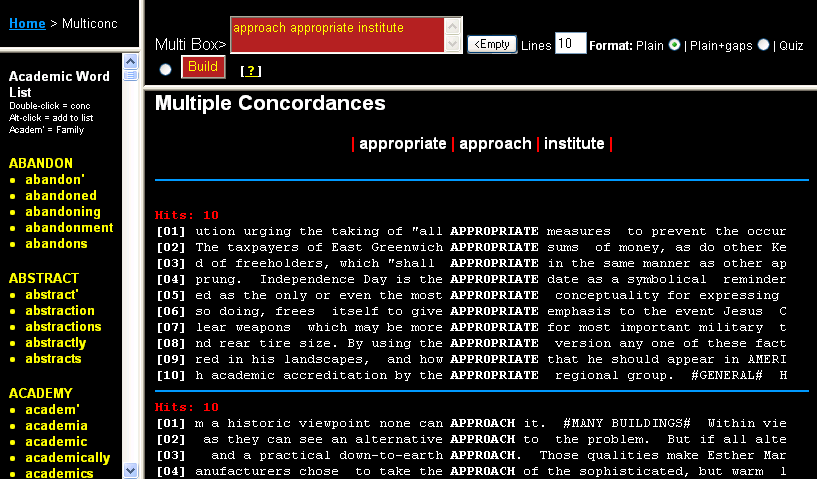
Figure 10: Multiple Concordances, plain mode
Group Lexicon is a collaborative vocabulary exercise builder. Currently available in a Demo version, learners can input their own vocabulary words, example sentences, word class, definitions, or word category (e.g. Arts), and can store these entries by learner's name. Learners can select these words to create multiple-choice quizzes. With Speaks for Itself installed, learners can also listen to the target language by running their mouse over any of the words on the screen. Should errors be found, either learners or instructors can edit the entries. (When editing, avoid using the browser's "back" button--this causes error messages to appear. Instead, clicking on the blue link in the lower left corner, "See all the entries", will return the user to the main page.)
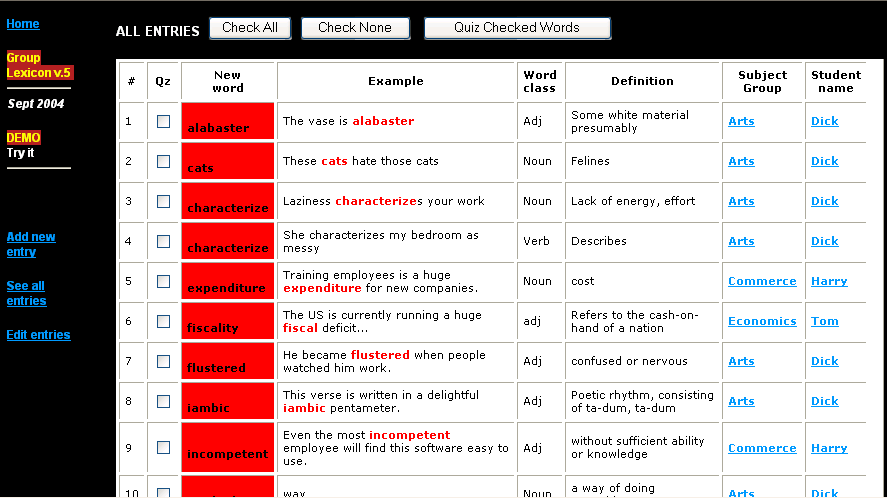
Figure 11: Group Lexicon, output
[-8-]
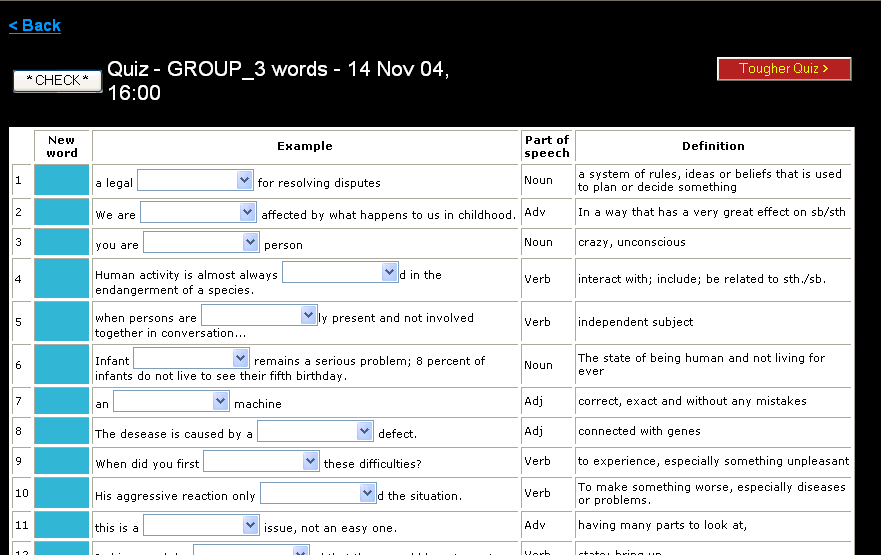
Figure 12: Group Lexicon, quiz with link to "Tougher Quiz"
A new feature on GroupLex offers a link to a "tougher quiz" based on the Brown corpus rather than the students' examples but still using their input vocabulary items. This can be accessed only through quizzes based on ALL the words input by a single group or subject area but achieves the aim of enabling learners to further recycle their vocabulary in new contexts.
Dictator is a dictation-based spelling activity builder utilizing the Speaks for Itself text-to-speech download. The instructor either types words into the Word Box or inserts words from the AWL (by clicking on items while pressing the ALT-key). The instructor selects either the "Train" or "Test" button and then clicks "Build".
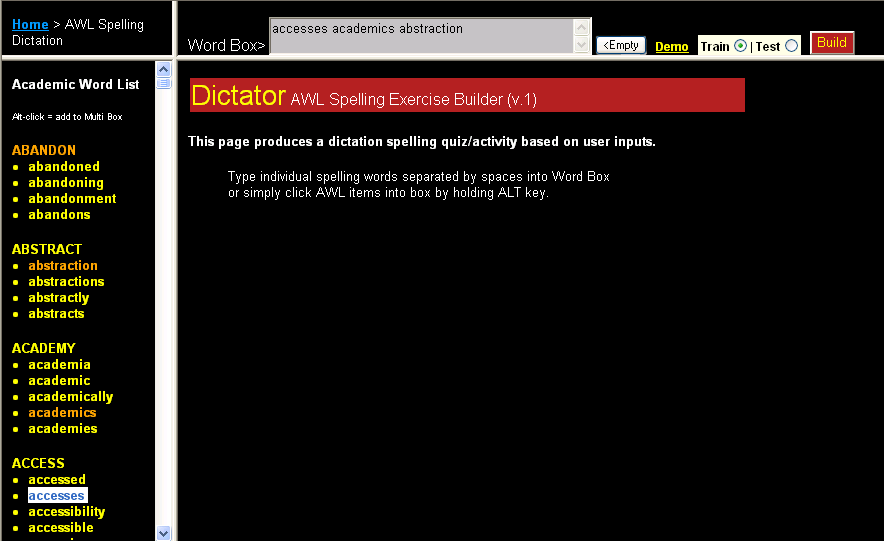
Figure 13: Dictator, with input in Word Box
When "Train" is clicked, a spelling practice activity is generated (Figure 14). The learner clicks on a numbered Word Box, listens to a word, and attempts to type it correctly into the adjacent empty box. The program gives feedback on how much of the word has been correctly spelled, and the learner can also refer to the input words at the top of the page. [-9-]
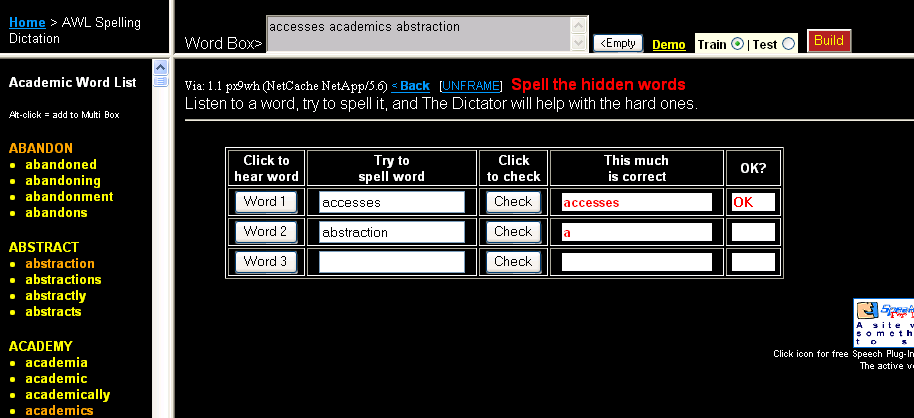
Figure 14, Dictator in "Train" mode
The "Test" mode is somewhat more difficult (though the items are still at the top of the page; they can be "hidden" by clicking "Unframe") because no interim feedback is given; students must attempt ALL words before they are allowed to check the accuracy of their responses, and correct answers are not shown. Thus, students can make repeated attempts until all words are spelled correctly.
To conclude (not easy--the site keeps growing), the Compleat Lexical Tutor is recommended for those looking both for practical, easily-developed activities as well as a bit of inspiration. The interface is not particularly user-friendly and the lack of instructions on how to use many of the activities poses a challenge. My colleagues and I have produced simple worksheets with links to specific activities on the site to remedy this problem, and I would recommend that other instructors do the same. Ours use screenshots from the site to introduce students to specific activities and focus their attention on the learning objectives of each activity. Instructors looking for "instant lessons" will be disappointed in The Compleat Lexical Tutor, but with time and a bit of effort, they will find this to be a very useful website.
[1] Academic Word List. Information and list retrieved November 6, 2004, from http://www.vuw.ac.nz/lals/research/awl/awlinfo.html .
[2] WordNet dictionary. Retrieved November 6, 2004, from http://www.cogsci.princeton.edu/cgi-bin/webwn.
Cobb, T. (n.d.). Why & how to use frequency lists to learn words. Retrieved October 1, 2004, from http://www.lextutor.ca/ResearchWeb/
Cobb, T. (1999). Breadth and depth of vocabulary acquisition with hands-on concordancing. [Electronic version]. Computer Assisted Language Learning 12, 345-360. Retrieved November 20, 2004, from http://www.er.uqam.ca/nobel/r21270/cv/Breadth.htm
Folse, K. (2004). Vocabulary myths: Applying second language research to classroom teaching. Ann Arbor: The University of Michigan Press.
Nation, P. (2001). Learning vocabulary in another language. New York: Cambridge University Press.
Nation, P. & Waring, R. (1997). Vocabulary size, text coverage and word lists, In N. Schmitt & and M. McCarthy (Eds.), Vocabulary: Description, acquisition and pedagogy (pp. 6-19). Cambridge: Cambridge University Press. Retrieved November 6, 2004, from http://www1.harenet.ne.jp/~waring/papers/cup.html
West, M. (1953). General service list, In J. Bauman & B. Culligan (1995), About the GSL. Retrieved November 6, 2004, from http://jbauman.com/gsl.html
Xue, G. & Nation, I.S.P. (1984). A University Word List. Language Learning and Communication 3, (2), 215-229.
Marti Sevier
English Bridge Program
Simon Fraser University
Burnaby, British Columbia, Canada
<msevier sfu.ca>
sfu.ca>
|
© Copyright rests with authors. Please cite TESL-EJ appropriately.
Editor's Note: Dashed numbers in square brackets indicate the end of each page for purposes of citation.. |
|
||||||||||